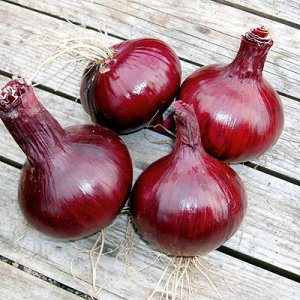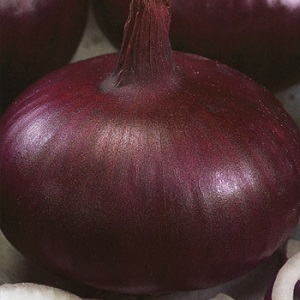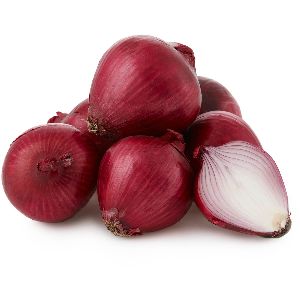Mid-season onion "Carmen" with a mild taste
Carmen is an unpretentious mid-season onion variety. People call it red or lilac. The culture is popular due to its unusual color, mild taste, and rich vitamin composition.
From the article you will learn how to properly grow Carmen onions in the garden, what are the advantages and disadvantages of this variety.
The content of the article
Description of the variety
Onion Carmen is widespread in the Russian Federation, including in the northern regions.
The variety is characterized by the following features:
- an average ripening period of 75 to 90 days;
- an excellent germination rate of up to 100%.
- high yield;
- small nesting (1-2 bulbs in the nest);
- the average size of neat bulbs, their average weight is 50-70 g;
- snow-white pulp with lilac veins and dark red or purple husks;
- excellent keeping quality of the crop.
Reference. Carmen onions are especially tasty when fresh. It is recommended to use it when preparing salads. It is not advisable to heat the bulbs. When stewing, baking and cooking, most of the nutrients are lost.
Origin and development
Carmen is an achievement of Dutch selection. The variety is popular all over the world, but in Russia it began to be grown not so long ago. He fell in love with domestic gardeners for a pleasant mild taste and unpretentious care.
Chemical composition, trace elements and vitamins and beneficial properties
The Carmen variety is distinguished by its rich chemical composition and medicinal properties, due, in particular, to the high content of anthocyanins. These antioxidant substances give onion skins a beautiful purple color.
Red onions are rich in flavonoids, in particular quercetin. It has anti-inflammatory, antihistamine, antispasmodic, diuretic effects.
The vegetable culture of this varietal accessory is rich in essential oils, useful microelements (magnesium, iron, potassium and others), vitamins. Differs in a high content of ascorbic acid - its onion contains from 4 to 19.5 mg.
Carmen bulbs contain a lot of sucrose and fructose.
Eating vegetable crops of this variety:
- reduces the risk of developing cancer;
- reduces the level of "bad" cholesterol;
- reduces the activity of bacteria and viruses.
Ripening period
Carmen is a mid-season variety. From the moment of planting seeds to harvesting, it takes from 75 to 90 days. After 100 days, yellowing of onion feathers is observed.
Reference. If you grow vegetables from seedlings, onions ripen in 6-7 weeks. This makes it possible to collect 3 crops per summer in the southern regions of the country.
Yield
The variety is characterized by a high yield. 1.5-2.5 kg of onions are harvested from 1 m2 of planting, 15-17 tons on industrial fields from 1 hectare.
Disease resistance
Carmen is characterized by strong immunity to diseases and is not prone to shooting. Onions are not susceptible to rot, downy mildew and rust. It is rarely harmed by thrips and onion flies.
Characteristics of the bulb, description of the appearance, taste
The bulbs are round, strong enough, covered with dark red or purple husks. They have white flesh with lilac streaks.
The average weight of a bulb is 50-70 g. Under particularly favorable conditions, it reaches 120 g. Green feathers have a length of 30 cm.
The bulbs are sweet, juicy, moderately spicy. The fibers do not differ in density.
For which regions it is best suited and what is the exacting climate
Onion Carmen grows well in the regions:
- Central;
- Middle Volga;
- Central Black Earth.
It can also be grown in the northern part of the country. The variety tolerates temperature extremes, drought and rainy periods well.
Important. Vegetable culture is light-requiring. Lack of sunlight provokes fungal diseases.
The main advantages and disadvantages of the variety
Among the advantages of this varietal onion:
- the possibility of growing in any region;

- cold resistance;
- strong immunity;
- high productivity;
- bulbs of the same size, even;
- attractive presentation and excellent taste;
- good keeping quality.
Disadvantages of the variety are practically absent, with the exception of demanding soil for growing.
What is the difference from other varieties
Carmen differs from other varieties of onions:
- special mild taste, sweet and slightly spicy;
- appearance;
- high content of vitamins;
- the presence of anthocyanin antioxidants in the vegetable;
- resistance to diseases and pests.
Comparison of popular varieties of onions:
Features of planting and growing
Carmen in the garden is grown from seeds or from small annual bulbs (sevka). Sevok should be of high quality, even and dense. Otherwise, there will be no good harvest.
Reference. Experienced gardeners sow seeds for the first year to obtain sets, and in the second year they plant them to get large onion heads.
Preparing for landing
Sevok requires preliminary preparation before planting in open ground. The bulbs are kept in a weak solution of potassium permanganate, then heated on a battery. After germination, covered with wet gauze. As soon as the shoots appear, they start planting.
The onion site is prepared in the fall. They choose a place well lit by the sun, where potatoes, cabbage, cucumbers, beans, and tomatoes were previously grown. The earth is fertilized with humus. In the spring, before planting, the soil is sprinkled with wood ash to prevent the bulbs from rotting.
Ground requirements
The Carmen variety is picky about the soil. Sour soil is not suitable for growing vegetables. The situation can be corrected by liming and creating high beds. Red onions grow well in neutral soils. When grown in sandy soil, the lowest possible beds are required.
Timing, scheme and landing rules
Landing time determined by the climatic conditions of the area and lasts from the second half of April to the first days of May. The ground should be warmed up to + 16ºC.
Onions are planted according to the standard scheme. The distance between the rows should not exceed 20 cm, between the holes 5-7 cm.The depth of the hole is 2.5-3 cm.
Growing features
Vegetables have not been grown on the same plot for several years in a row. There is a risk of fungal infection.It is recommended to return to the former landing site not earlier than after 4 years.
The nuances of care
The variety does not need special care. But it is important to follow the basic procedures:
- carefully weed the beds (weed residues can provoke plant diseases);
- water as the soil dries up;
- control the presence of pests and destroy them in a timely manner.
Watering mode
After planting, the onions need abundant watering, then the frequency is reduced. They try to avoid waterlogging in order to protect the planting from fungal infection. If it rains regularly, watering is stopped altogether.
Loosening the soil and weeding
Onions are picky about soil aeration, they do not tolerate weeds. When growing it requires:
- shallow loosening of row spacings the next day after each watering or rain.
- regular weeding to eliminate weeds.
Top dressing
The variety requires 2-3 dressings during the season according to the scheme:
- introduction of nitrophoska, urea 14 days after planting;
- feeding with phosphorus-potassium fertilizers 28 days after planting;
- on the 43rd day, re-introduction of the phosphorus-potassium composition.
Reference. After fertilization, the soil is watered abundantly, their residues are washed off the plants.
Disease and pest control
The most dangerous pests of vegetable crops:
- onion lurker;
- onion fly;
- stem nematode;
- onion moth;
- root mite.
Spraying plants with the following means will help prevent pests and infection by fungal organisms:
- "Glyocladin";
- Fitosporin-M;
- "Alirin";
- "Gamair";
- Tsineb's solution (0.04%);
- copper oxychloride solution (0.5%);
- Bordeaux mixture.
Harvesting and storage
Timely harvest and correct storage conditions are the key to a high keeping quality of the product.
How and when to collect
Harvesting is carried out in late August - early September, depending on the region. Watering is stopped 30 days before harvesting. The onions are dug out when the feathers are dry and the tops of the onions are visible from the ground. Do this in clear dry weather.
Storage features and keeping quality of the variety
The harvested crop is dried in the sun, then stored in a dry, clean place, where the humidity does not exceed 70%. Carmen's bow is good. The crop is stored almost without loss for 8 months.
What can be the difficulties in growing
When growing Carmen onions, sometimes the following difficulties arise:
- yellowing of feathers;
- the appearance of bitterness in the bulb.
Causes of yellowing:
- deficiency of nitrogen in the soil;
- the culture is affected by a pest or disease;
- violation of agricultural technology.
Causes of bitterness:
- deficiency of phosphorus fertilizers;
- dry soil.
Tips from experienced gardeners
For the prevention of diseases and pests, experienced gardeners recommend:
- refuse to use questionable and low-quality planting material;
- to carry out pre-planting processing of soil and equipment "Inta-Vir", "Iskra", "Thunder";
- plant garlic, coriander, horseradish, wormwood, marigolds next to the Carmen onion garden.
Reviews of the Carmen onion variety
Reviews of the Carmen onion variety are overwhelmingly positive.
Nikolay 54 years old, Tver: “My friends told me about the Carmen bow a couple of years ago. I got seeds and started growing. There were no particular difficulties in growing. Care is similar to caring for a regular onion. The next year I planted sevok. Gathered a good harvest at the end of August. I like this onion for its pleasant sweetish taste. "
Nina 46 years old, Novosibirsk: "Despite the fact that I live in Siberia, I managed to grow many different vegetable crops in my garden. Two years ago I decided to grow the red Carmen variety. Gathered an excellent harvest, which pleased with a not very spicy taste. The variety has good keeping quality, the harvest lasted the whole winter with practically no losses. "
Conclusion
Carmen is an unpretentious, resistant to unfavorable conditions variety with excellent taste.Growing a crop in accordance with all the rules of agricultural technology, you will get an excellent harvest with minimal maintenance. Carrying out basic sulfur prevention, it is easy to protect the crop from pests and diseases.